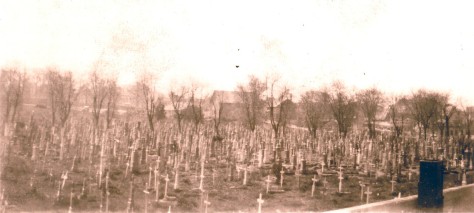
A landscape dotted with rusted metal markers and wooden crosses, Most Holy Trinity Cemetery in Brooklyn is one of the city’s most unique and visually arresting graveyards. Nestled at the end of Central Avenue in Bushwick and bounded by Evergreens Cemetery and the tracks of the NYC Subway’s L train, the 23-acre cemetery was established in 1851 as a new cemetery for Most Holy Trinity Church, the first German Catholic church in Williamsburg. The parish cemetery was originally located behind the church at Montrose Avenue in East Williamsburg; when a new church building and schools were planned for that site, a four-acre parcel of land was purchased from Evergreens Cemetery to serve as a church cemetery. The remains from the Montrose Avenue site were transferred to the new Most Holy Trinity Cemetery and, as the need for burial space grew over the years to accommodate an estimated 25,000 graves, the church purchased additional parcels from Evergreen until the parish cemetery reached its present size.
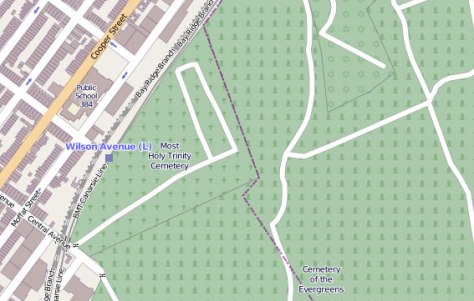
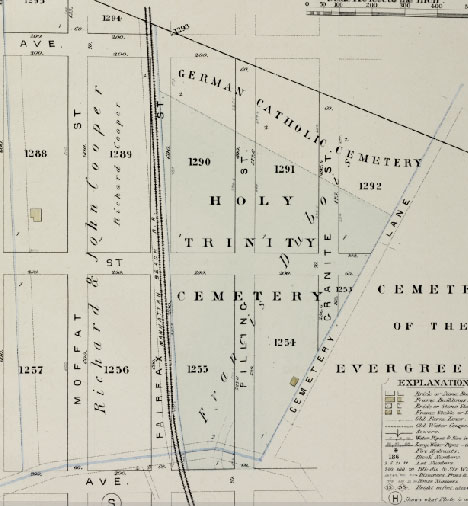
When Most Holy Trinity Cemetery was created, the church resolved that no distinctions were permitted to be made between the rich and the poor, and the rule was established that no stone monuments could be erected. Until very recent times, when flat gravestones have been permitted, only simple wooden and metal markers indicated the resting places of the dead. This “democratic equality of the grave” set the graveyard apart from others in the area and the markers created a remarkable visual spectacle. An 1890 article in the Brooklyn Daily Eagle described it:
The monuments that surmount [the graves] present a curious picture and one that has not a parallel in any other cemetery in the neighborhood of these two cities . . . the monuments are now all of wood, or, especially the later ones, of galvanized iron, dressed in imitation of gray granite. Nearly all of them have crosses rising above them, but the peculiar feature of nearly every one of them is that it is decorated with highly gilded figures of the crucifix, the winged head of a cherub and lamb. Some stones contain all of these three figures, some only one. They sparkle everywhere among the thickly strewn white and gray monuments and give the peculiar aspect to the cemetery that distinguishes it decidedly from all others.
Today, few of the numerous wooden crosses that once filled the cemetery are still present and the weatherworn crucifixes have lost their gilding. Large grassy areas, probably once filled with wooden crosses, now have only a few markers scattered here and there. The rusted metal markers, many strangely crumpled and peeling with paint, add to the peculiar atmosphere of this most interesting site.
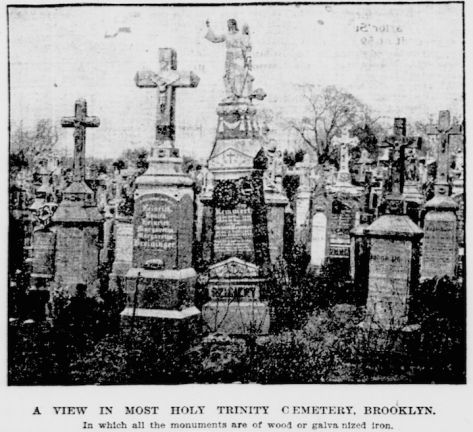
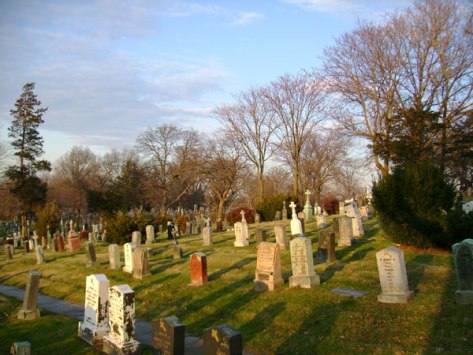

View more photos of Most Holy Trinity Cemetery.
Sources: OpenStreetMap; Hopkins’ 1880 Detailed Estate and Old Farm Line Atlas of the City of Brooklyn, Vol. 2, Pl. R; The History of Most Holy Trinity Cemetery; “Crosses Gone from Hundreds of Graves in the Trinity Cemetery,” Brooklyn Daily Eagle, July 24 1890, p.6; “Holy Trinity Cemetery. A Unique Burial Ground Which Is a Multiplied Golgotha,” Brooklyn Daily Eagle, Nov 26 1899, p.18; “An Oddity in Burial Grounds,” New-York Tribune Mar 10 1901, A7 “A Village Churchyard,” Thomas F. Meehan, Historical Records and Studies 7, 1914, p.183-194.
